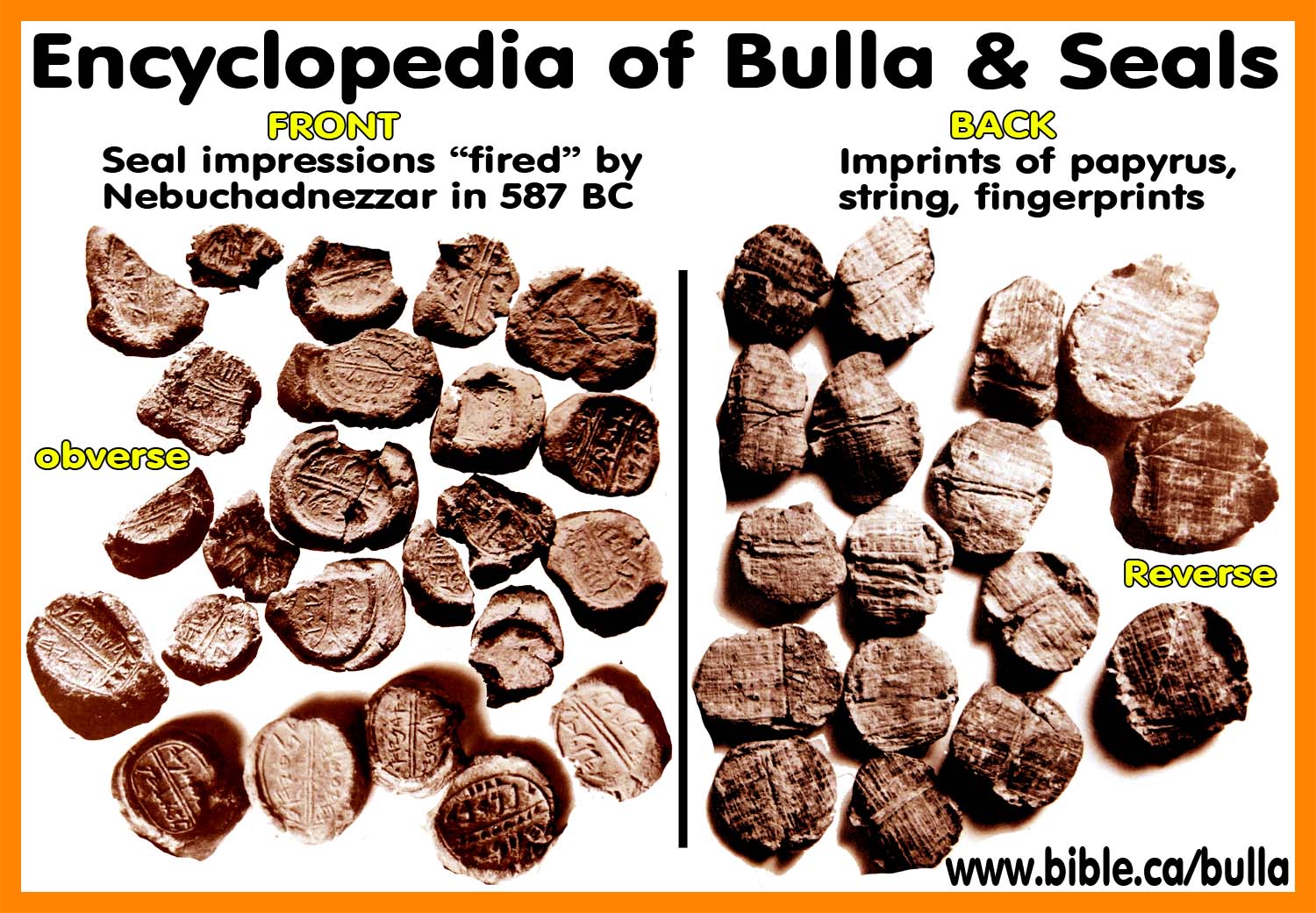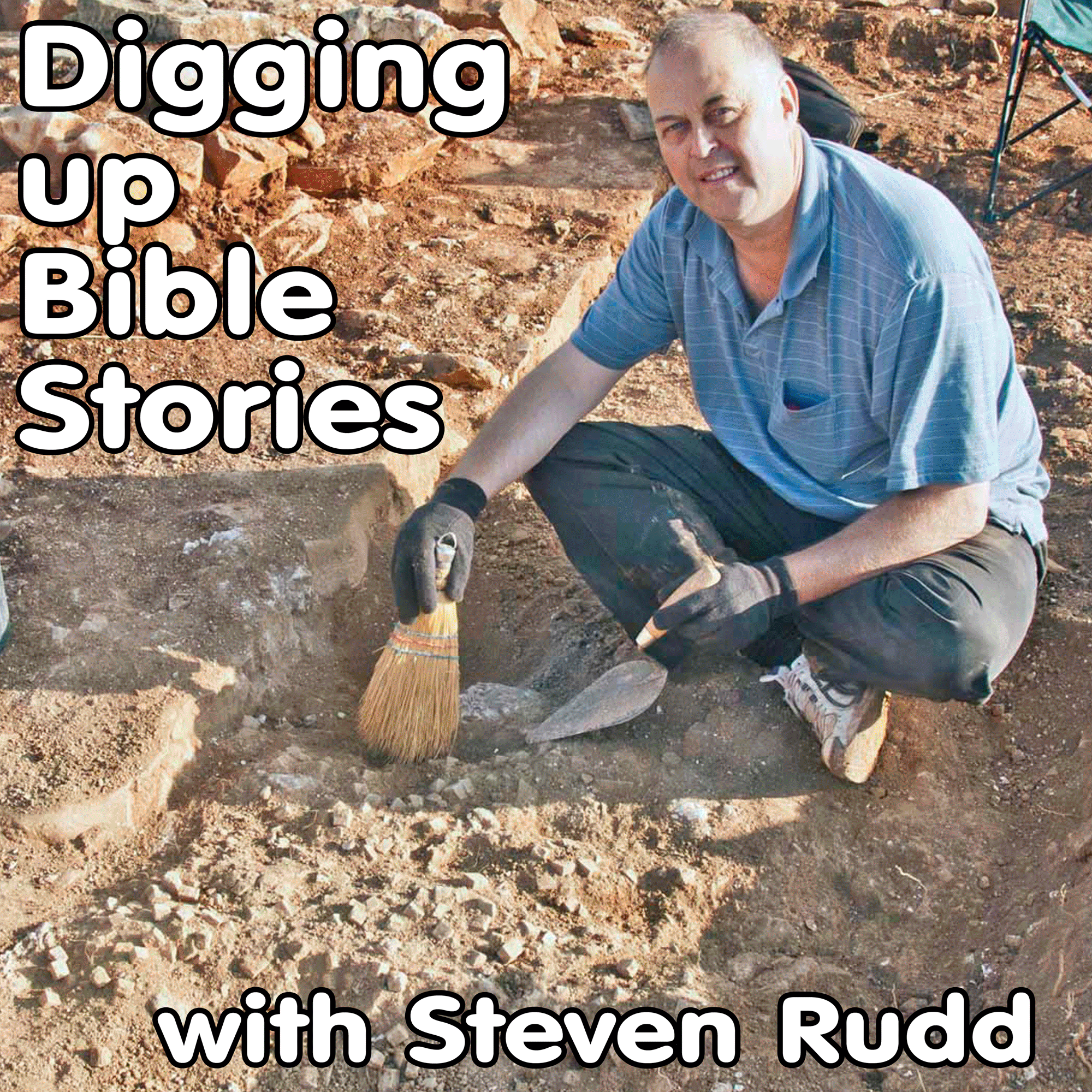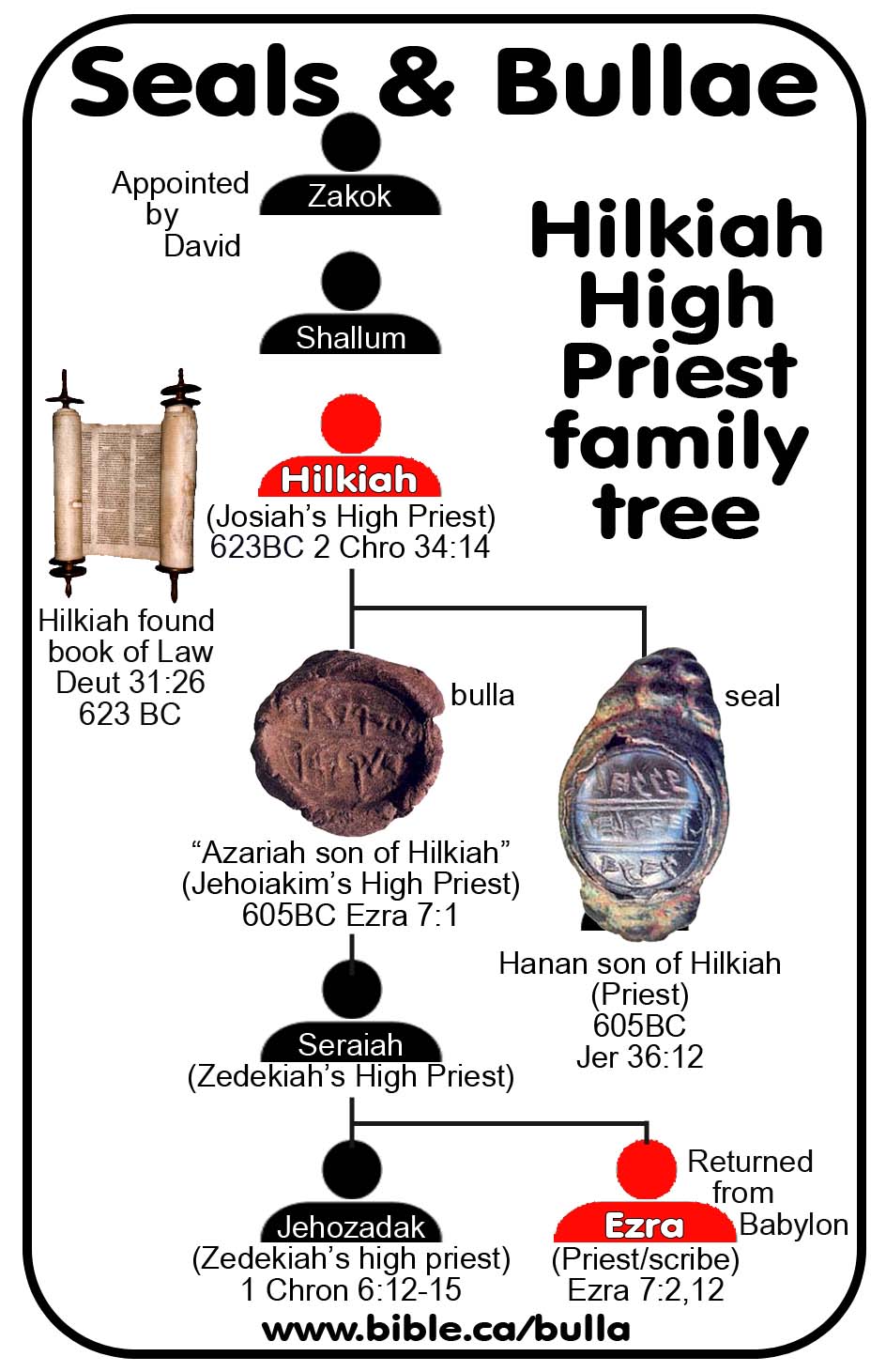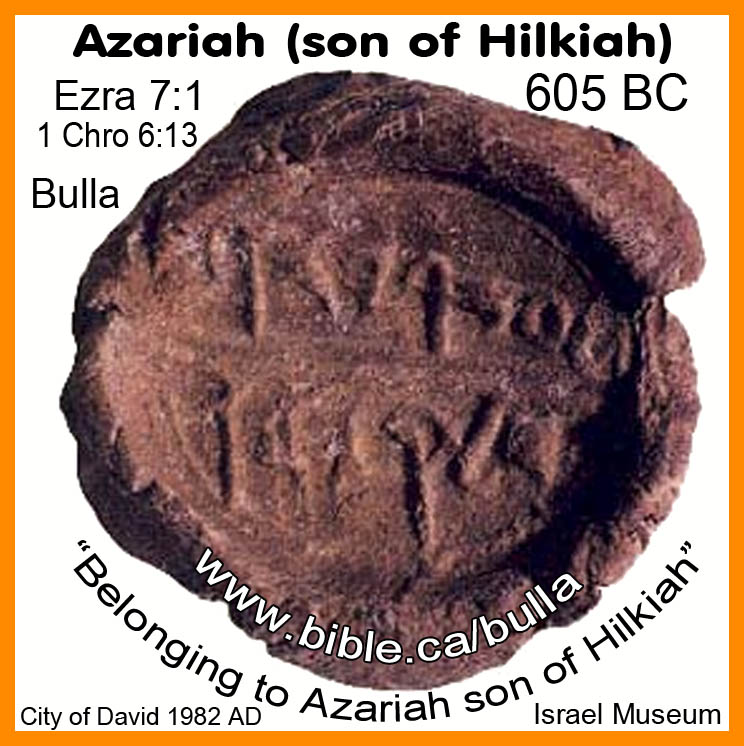Bulla of Hanan son of Hilkiah the high priest
Bible Bullae from Israel and Judah
|
Bulla of Hanan son of Hilkiah "Archaeologists are digging up bible stories!!!" 1. Glyptic artifact: Agate seal mounted in bronze ring 2. Inscription: "Belonging to Hanan son of Hilkiah" 3. Provenance: None: Private antiquities market 1980 AD. 4. Current location: Unknown private collection 5. Date: 605 BC 6. Bible verses: Jer 36:12; 2 Chron 34:14 7. Events: Nebuchadnezzar's 1st attack on Jerusalem during the reign of Jehoiakim, the Bible burning king. |
|
|
||||||
|
Encyclopedia of Bullae and Seals: The Exhibit: On-line Museum of Bulla and seals Security: How bullae are made to seal papyrus Forgeries: Known fake bullae and seals |
||||||
|
|
||||||
|
Archaeologists are digging up bible stories!!! |
||||||
|
Archaeology is an important science that confirms the historical accuracy of the Bible. Since the Bible refers to hundreds of cities, kings, and places, we would expect to find evidence from on-site excavations. And this is exactly what we have found. The Bible is the most historically accurate book of history on earth. Read the Bible daily! |
|
|||||
|
|
||||||
Encyclopedia of Bullae and Seals of Judea and Israel
|
Bulla "belonging to Hanan son of Hilkiah" 1. Glyptic artifact: Agate seal mounted in bronze ring 2. Inscription: "Belonging to Hanan son of Hilkiah" 3. Provenance: None: Private antiquities market 1980 AD. 4. Current location: Unknown private collection 5. Date: 605 BC 6. Bible verses: Jer 36:12; 2 Chron 34:14 7. Events: Nebuchadnezzar's 1st attack on Jerusalem during the reign of Jehoiakim, the Bible burning king. |
Introduction:
1. It is 605 BC in the 5th year of Jehoiakim king of Judah.
a. Jeremiah is directed by God to write a scroll to warn Judah that Jerusalem will be destroyed unless they repent of their idolatry.
b. Jeremiah's scribe, Baruch the son of Neriah (click to see Bulla of Baruch) is given the task of reading the inspired message of doom.
c. Baruch reads the scroll in the royal scribe's chamber to all the kings officials including Hanan (or Hananiah)!
d. King Jehoiakim burns Jeremiah's scroll in December in the fireplace of his winter palace.
e. See outline: Jehoiakim, the Bible burning king.
f.
It is during this time that Azariah was high priest and here is his ring
seal

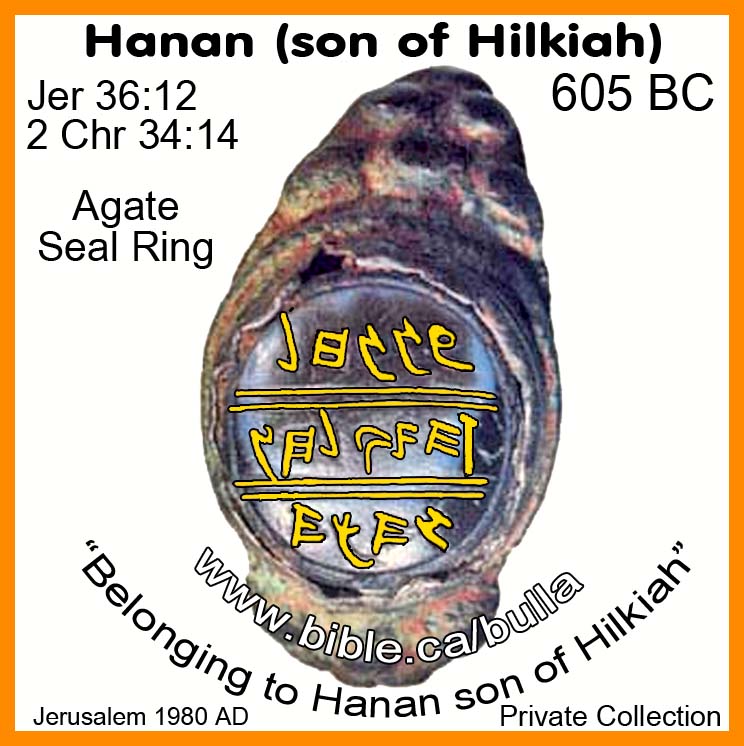
2. SEAL OF HANAN, SON OF HILKIAH:
a.
Hanan, Hananiah is a very common name found in the Bible during the
entire time from David down to the time of Nehemiah. This Hanan, however, is
specifically unknown to scripture as the son of Hilkiah the high priest. The
seal is actually part of a ring, which is typical. This incredible artifact
surfaced in the antiquities market in Jerusalem in 1980 AD via an antiquities
dealer and is therefore unprovenanced. Since it was NOT excavated as part of an
official archeological dig, there is always the chance it is a fake. However,
there are many genuine seals and bullae that surface this way and there is no
reason to question its authenticity.

b. Here is the detailed outline on the bulla of Azariah son of Hilkiah
3. Archeology has verified two sons of Hilkiah:
a.
The Seal
of Hanan and the bulla
of Azariah.


a. Azariah and Hanan were brothers and sons to Hilkiah the high priest while Jeremiah was unrelated, being the son of a different priest named Hilkiah from Anathath.
I. Archeological information about the bulla of Azariah son of Hilkiah:
1. The ring seal of Hanan (or Hananiah) son of Hilkiah the high priest was not discovered through an official archeological dig:
a. The seal ring of Hanan is unprovenanced and surfaced from unknown sources on the private antiquities market in 1980 and is part of an unknown private collection.
b. The current location of Hanan's seal is unknown.
c. However, it is judged to be authentic because the same person created both the seals (which made the bulla) of Azariah and Hanan.
i. This is important because since we know the bulla of Azaria came from a provenanced legal, controlled dig in the City of David in 1982 AD, it helps to validate the seal of Hanan.
ii. The came from an official archeological dig in the City of David.
iii. It is possible, however, that the seal of Hanan is a forgery and the forgers copied the script style from the Azariah bulla
iv. This underscores why looting of archeological sites for profit is a crime against humanity because if left to be discovered by professional archeological teams, more people would be certain of the Bible and less likely to spend eternity in hell.
2. "An additional bulla and a seal set in a ring are assigned to two sons of Hilkiah, Josiah’s high priest (Elayi 1992:680–85; Schneider 1988:139–41; 1991:30–33). One son, Azariah, who served as high priest before the Babylonian exile (1 Chr 4:39; 9:11) is connected to the bulla impressed, לעזריהו ב/ן חלקיהו, “(belonging) to Azariabu son of Hilkiahu.” A second son, not mentioned in the Bible, is identified as the owner of the seal engraved, לחנן ב/ן חלקיהו/הכהן (belonging) to Hanan son of Hilkiahu the priest.” Recently, Elayi showed that the same seal-cutter probably carved the seals of Azariahu and Hanan (1992:682–84)." (Royal Officials and Court Families: A New Look at the םיךלי(yĕlādîm) in 1 Kings 12, N. Fox, Biblical Archaeologist: Volume 59 1-4, p 228, 2001 AD)
3. There is seal of Hananiah son of Azariah, who was a false prophet that opposed Jeremiah during the reign of Zedekiah:
a.
See detailed
outline on the seal of false prophet Hananiah son of Azariah
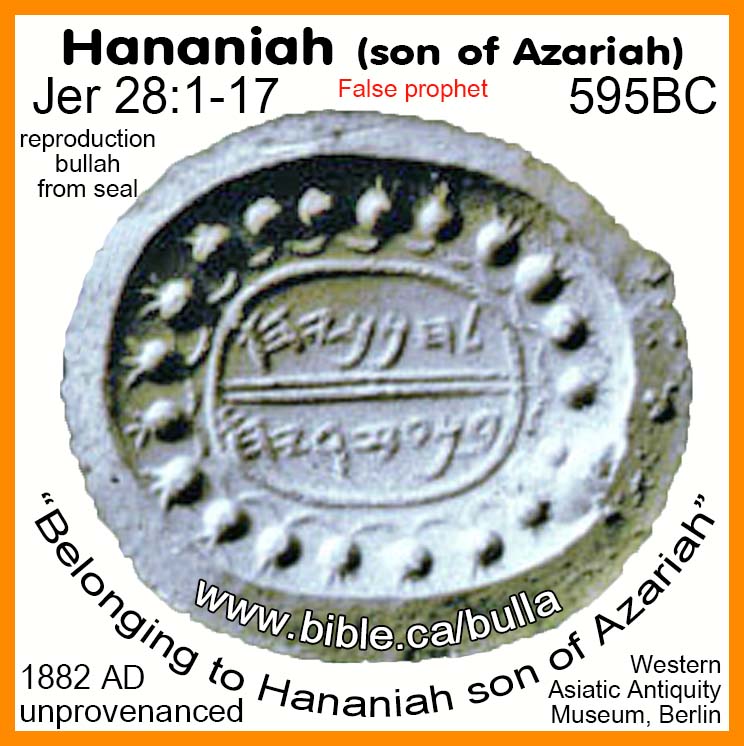
II. Bible verses for Hanan, Hannaniah:
Jer 36:12; 35:4; 1 Chronicles 8:23,38; 11:43; Neh 7:49; 8:7
1. There are no Bible verses that connect Hanan with Hilkiah but Hanan was a common name throughout the Babylonian-Persian era (700-333 BC.)
2. The best possible choice for Hanan son of Hikiah, is found in Jer 36:12 dated to 605 BC.
a. "he went down to the king’s house, into the scribe’s chamber. And behold, all the officials were sitting there—Elishama the scribe, and Delaiah the son of Shemaiah, and Elnathan the son of Achbor, and Gemariah the son of Shaphan, and Zedekiah the son of Hananiah, and all the other officials." (Jeremiah 36:12)
3. "and I brought them into the house of the Lord, into the chamber of the sons of Hanan the son of Igdaliah, the man of God, which was near the chamber of the officials, which was above the chamber of Maaseiah the son of Shallum, the doorkeeper." (Jeremiah 35:4)
4. "Abdon, Zichri, Hanan," (1 Chronicles 8:23)
5. "Azel had six sons, and these were their names: Azrikam, Bocheru, Ishmael, Sheariah, Obadiah and Hanan. All these were the sons of Azel." (1 Chronicles 8:38)
6. "Hanan the son of Maacah and Joshaphat the Mithnite," (1 Chronicles 11:43)
7. "the sons of Hanan, the sons of Giddel, the sons of Gahar," (Nehemiah 7:49)
8. "Also Jeshua, Bani, Sherebiah, Jamin, Akkub, Shabbethai, Hodiah, Maaseiah, Kelita, Azariah, Jozabad, Hanan, Pelaiah, the Levites, explained the law to the people while the people remained in their place." (Nehemiah 8:7)
III. Bible verses for Azariah, son of Hilkiah the high priest:
Ezra 7:1-5; 2 Kgs 22:4-14; 23:4; 2 Chro 34:14; 1 Chr 5:39; 6:13; 9:11; Jer 1:1
1. "and Azariah the son of Hilkiah, the son of Meshullam, the son of Zadok, the son of Meraioth, the son of Ahitub, the chief officer of the house of God;" (1 Chronicles 9:11)
2. "When they were bringing out the money which had been brought into the house of the Lord, Hilkiah the priest found the book of the law of the Lord given by Moses." (2 Chronicles 34:14)
3. "Ahitub became the father of Zadok, and Zadok became the father of Shallum, and Shallum became the father of Hilkiah, and Hilkiah became the father of Azariah, and Azariah became the father of Seraiah, and Seraiah became the father of Jehozadak; and Jehozadak went along when the Lord carried Judah and Jerusalem away into exile by Nebuchadnezzar." (1 Chronicles 6:12-15)
4. "Now after these things, in the reign of Artaxerxes king of Persia, there went up Ezra son of Seraiah, son of Azariah, son of Hilkiah, son of Shallum, son of Zadok, son of Ahitub, son of Amariah, son of Azariah, son of Meraioth, son of Zerahiah, son of Uzzi, son of Bukki, son of Abishua, son of Phinehas, son of Eleazar, son of Aaron the chief priest." (Ezra 7:1–5)
5. “Go up to the high priest Hilkiah, and have him count the entire sum of the money that has been brought into the house of the Lord, which the keepers of the threshold have collected from the people; let it be given into the hand of the workers who have the oversight of the house of the Lord; let them give it to the workers who are at the house of the Lord, repairing the house, that is, to the carpenters, to the builders, to the masons; and let them use it to buy timber and quarried stone to repair the house. But no accounting shall be asked from them for the money that is delivered into their hand, for they deal honestly.” The high priest Hilkiah said to Shaphan the secretary, “I have found the book of the law in the house of the Lord.” When Hilkiah gave the book to Shaphan, he read it. Then Shaphan the secretary came to the king, and reported to the king, “Your servants have emptied out the money that was found in the house, and have delivered it into the hand of the workers who have oversight of the house of the Lord.” Shaphan the secretary informed the king, “The priest Hilkiah has given me a book.” Shaphan then read it aloud to the king. When the king heard the words of the book of the law, he tore his clothes. Then the king commanded the priest Hilkiah, Ahikam son of Shaphan, Achbor son of Micaiah, Shaphan the secretary, and the king’s servant Asaiah, saying, “Go, inquire of the Lord for me, for the people, and for all Judah, concerning the words of this book that has been found; for great is the wrath of the Lord that is kindled against us, because our ancestors did not obey the words of this book, to do according to all that is written concerning us.” So the priest Hilkiah, Ahikam, Achbor, Shaphan, and Asaiah went to the prophetess Huldah the wife of Shallum son of Tikvah, son of Harhas, keeper of the wardrobe; she resided in Jerusalem in the Second Quarter, where they consulted her." (2 Kings 22:4-14)
6. "The king commanded the high priest Hilkiah, the priests of the second order, and the guardians of the threshold, to bring out of the temple of the Lord all the vessels made for Baal, for Asherah, and for all the host of heaven; he burned them outside Jerusalem in the fields of the Kidron, and carried their ashes to Bethel." (2 Kings 23:4)
7. "The words of Jeremiah the son of Hilkiah (different from Hilkiah the high priest), of the priests who were in Anathoth in the land of Benjamin," (Jeremiah 1:1)
Conclusion:
1. The seal of Hanan (Hananiah) son of Hilkiah is judged to be genuine because the two seals were carve by the same person based on script and character analysis.
a. Although there are no direct Bible verses, the best choice is Jer 36:12 which dates to 605 BC.
b. See detailed outline on the seal of Hanan son of Hilkiah
c. See detailed outline on the seal of false prophet Hananiah son of Azariah
2. The bulla of Azariah son of Hilkiah the high priest dates to 605 BC and is a spectacular archeological find that references two High Priests just before the Babylonian captivity of 587 BC.
3. The Bulla of Azariah is 100% provenanced because it came from the City of David dig in 1982 AD whereas the seal of Hanan is unprovenanced through the antiquities market but judged to be genuine because it shares the same script style as the seal which made the bulla of Azariah.
4. Both bulla of Azariah and the seal of Hanan date to 605 BC which was the year Nebuchadnezzar first attacked Jerusalem during the reign of Jehoiakim, the Bible burning king.
By Steve Rudd: Contact the author for comments, input or corrections.
